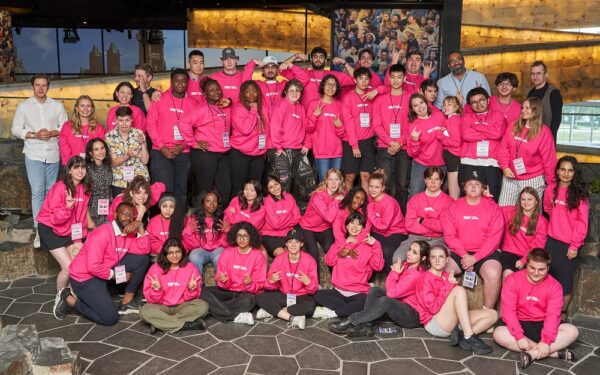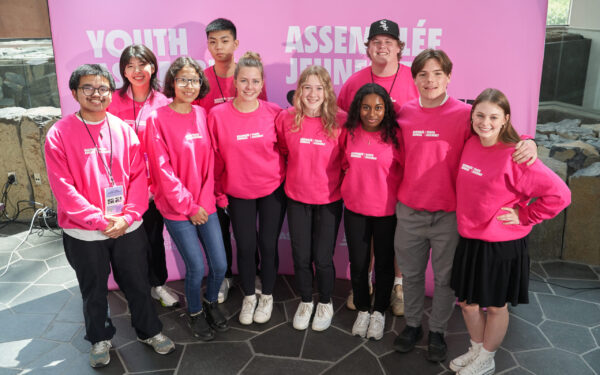Over the past eight years, CIRA’s grants program has funded 185 community-led internet projects across Canada. Our role in the grant-making space has afforded us the unique opportunity to fund a variety of projects that help shape the Canadian digital landscape. We’re exploring one grant recipient’s project and the role CIRA played, to highlight the impact of a CIRA grant, and to encourage applications from groups across Canada working to bridge our digital divides.
The STEAM Centre is tucked away in the small town of St. Thomas, Ontario. Executive Director Fred Cahill and Program Educator Dakota Ireland, among others, have created a space dedicated to providing students with science, technology, engineering, art and mathematical skills. The centre facilitates numerous hands-on opportunities including facility tours and workshops.
So why did the STEAM Centre apply for a CIRA grant? Since its inception, the Centre has been primarily focused on providing digital literacy programming to students at Antler River Elementary School, which sits on the Chippewas of the Thames First Nation. The team saw a need to deliver programming to low income and at-risk Indigenous youth in the community, along with a need to address the gap in digital literacy amongst local elementary school students. With the vision of combining Indigenous ways of knowing with STEAM-focused digital literacy education, the iSTEAM project was born.
The project initially catered to students ages 10-13 at Antler River Elementary School, but soon expanded to students at Standing Stone Elementary School. With the goal of merging the academic curriculum with new technology, the programming consisted of weekly workshops during the school year and a 3-day summer camp. These workshops encouraged students to develop new digital literacy skills as well as enhance soft skills, such as critical thinking. Some key workshop activities included learning stop motion video, coding video games, and utilizing digital drawing applications. By teaching one generation of Indigenous youth STEAM related skills, the team hoped that it would inspire a new accessibility to Indigenous art and culture in the digital age.

With the iSTEAM project initially set to launch in 2020, the team at the Centre was suddenly faced with the unexpected pandemic and all the obstacles it brought. However, against all odds, their programming managed to launch and exceeded expectations. The pandemic took a toll on both the educators and the students, but the team did not let this hinder the creative expression that their digital literacy workshops would evoke. In-person workshops including the summer camp were transitioned online into an asynchronous format in which the facilitators strived to maintain engagement and enjoyment. “In an environment where students are tired and stressed, iSTEAM offers a chance for a little point of control, something you can craft and make special that creates a sense of accomplishment—that is tremendously powerful.”, Cahill remarked proudly.
When asked why the STEAM Centre chose to apply for a CIRA grant, they explained that it seemed to be the only non-governmental funding source for Indigenous communities seeking funding for digital literacy programs. The limited funding options available for digital literacy projects, coupled with an increasing need to strengthen digital skills spurred by the pandemic, has become an urgent cause for concern in Canada. Currently and for the last few years, CIRA’s funding program has prioritized projects that benefit Indigenous communities.

Cahill and Ireland wanted to create a program that catered to the creative spirit of the Indigenous students in the community. In doing so, they inspired students to pursue their advancement of digital literacy skills while also embracing the fun of making something rather than simply learning a skill. Cahill emphasizes the need to explore the idea of ‘wonder’ by giving students the ability to take their natural born creativity and channel it into something digital: “It is so preciously important to treasure, learn and understand the cultural elements that are both so fragile and profound…and when you connect that to digital literacy and the tools of the future there are tremendous opportunities for inclusion and growth.” With the future becoming increasingly digital, iSTEAM was a way to provide students with the confidence to continue their creative endeavors in an online space.
CIRA’s Grants Program covers four funding areas: digital literacy, community leadership, infrastructure and cybersecurity. Our annual call for applications is open now till April 13, 2 p.m. ET. To find out more about project eligibility and how to apply for a CIRA grant, visit our website: https://www.cira.ca/community-investment-program/grants
Brooklin is a Grants Specialist with CIRA’s Community Investment Program. She joins CIRA on a co-op work term as a third year University of Ottawa student pursuing a degree in International Development and Globalization. She is especially interested in the non-profit funding field and the dynamics of funder-recipient relations.





